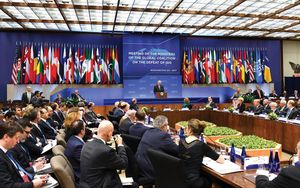India's economy is on track for significant growth, with the latest estimates projecting the country to add $383 billion to its GDP by 2025. While this growth marks India as the fastest-growing major economy, it still presents a stark comparison to China's expected $1.26 trillion increase, underscoring the economic challenges India faces as it strives for parity with its neighbor.
On February 5, 2025, Union Finance Minister Nirmala Sitharaman presented India’s Union budget for the upcoming fiscal year, outlining comprehensive fiscal policies and initiatives aimed at sustaining this growth. Sitharaman reiterated the government's commitment to fiscal consolidation and economic stability, alluding to the necessity of balancing capital investments with fiscal discipline to navigate both domestic and global challenges.
Reflecting on India's fiscal strategies, Sitharaman noted, "This tax proposal will make people have more money in their hands. When people have money in their hands, they make their judgment about whether they want to spend it entirely or spend some out of it and also make sure they save something else some amount from it." The finance minister emphasized the revised tax slabs are structured to be transparent and efficient, aiming to relieve taxpayers and stimulate consumer spending.
India's macroeconomic outlook remains positive, attributed largely to strong domestic consumption and significant government-led capital expenditures. Sitharaman asserted, "Despite all these (challenges), we have shown a commitment and followed the commitment to the last word as regards fiscal deficit and the glide path we should follow. We have, not one year, failed (to meet our commitment)." This stance on rigorous fiscal discipline is set against the backdrop of global economic turbulence, including inflation pressures and geopolitical tensions, where India's resilience is seen through its export performance and diversified economic structure.
Despite these efforts, global ratings agency Moody's expressed cautious optimism, ruling out immediate upgrades to India's sovereign rating. According to Christian de Guzman, Senior Vice President at Moody’s, "While we view the government's sustained fiscal discipline and narrower fiscal deficits as credit positive, we don't expect these improvements in the debt burden or 'debt affordability' to be enough to trigger a sovereign rating upgrade at this time." The current rating reflects India’s economic situation amid the complex interplay of fiscal realities and growth ambitions.
Addressing revenue targets and potential challenges with public-sector disinvestments, the government has expressed confidence about achieving set financial goals even with anticipated revenue loss from tax concessions. This assertion follows the insights from Tuhin Kanta Pandey, Revenue and Finance Secretary, who pointed out, "We are confident about achieving the non-tax revenue target next financial year. The US has not taken measures against India. So I don’t see any impact on the profitability of oil PSUs." His remarks came amid discussions on the intricacies involved with privatizing public-sector enterprises, noting difficulties with existing state-owned entities and their complex financial structures.
Sitharaman also highlighted the focus on infrastructure development as part of the government’s economic strategy, reaffirming commitments under the PM Gati Shakti initiative. Significant allocations for roads, railways, and ports aim to bolster connectivity, inviting participation from private enterprises in infrastructure investments to stimulate economic growth. The National Monetisation Pipeline (NMP) is another avenue through which the government seeks to generate new revenue streams by efficiently operationalizing existing assets.
While the government remains steadfast about maintaining its capital expenditure, reflecting optimism about the banking sector's stability and credit growth, Sitharaman acknowledged the influence of global economic conditions. The substantial commitment is highlighted by the intention to keep fiscal spending aligned with developmental goals without compromising social welfare programs. Further details on public capital investment were shared, where Sitharaman noted the modest increase projected for the next financial year compared to past expenditures.
Challenges remain for India’s agriculture sector as well, where the government asserts its dedication to enhancing productivity and rural infrastructure through innovations and programs aimed at improving farmers' incomes. These initiatives will also look at integrating agri-tech solutions to modernize farming practices.
On the taxation front, Sitharaman emphasized the importance of maintaining transparency and compliance. The Goods and Services Tax (GST) framework’s stability, alongside efforts to simplify tax procedures, reflects the government's commitment to boosting the business environment. The overarching narrative here is one of fostering growth through prudent fiscal measures, supportive tax policies, and steadfast investment in infrastructure.
Digital advancements are also pivotal, with the government set to explore the benefits of artificial intelligence (AI), fintech, and other innovative technologies as part of its economic growth strategy. Sitharaman's focus on cybersecurity and the robustness of India’s digital infrastructure are equally significant as these elements are posed as core to the future of India's economic positioning on the global stage.
Looking at the fiscal deficit, the budget set it at 4.8% of GDP for the current year, laying out plans to reduce this figure below 4.5% by 2025-26. This disciplined approach is complemented by long-term debt management strategies aimed at ensuring the country maintains sustainable economic growth, all the more necessary as international economic uncertainties persist.
India’s economic outlook is characterized by ambition; improvements are on the horizon, but the road remains fraught with challenges. A comprehensive approach, balancing fiscal prudence with expansive expenditure, will be key to shaping India's place within the global economy over the coming years. The union budget sets the tone for sustained growth against the backdrop of formidable economic hurdles, reinforcing the government’s resolve for continuous reform and investment.



